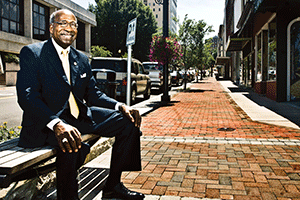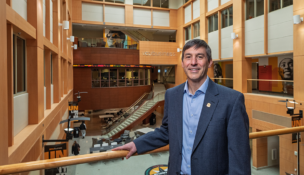Danville gets a new look
City is humming with downtown development as streets get a makeover
Danville gets a new look
City is humming with downtown development as streets get a makeover
Mayor Sherman Saunders, a proponent of
downtown revitalization, is surrounded
by recently completed sidewalk and
landscape additions on Main Street.
There’s a new buzz about Danville, centered around its dramatic downtown streetscape renovations. After years of planning, public forums and preparation, the changes now are in full swing.
Sidewalks and streets are torn up, making way for wider sidewalks designed to be more attractive to pedestrians — with benches, landscaping and interesting mixes of brick, cobbles and pavers to break up the concrete. The sidewalks also offer restaurants space for outside tables and shopkeepers room to display some of their wares outside.
Robin Jones, owner of Vintages by the Dan on Main Street, is relieved her block is done and thrilled with the outcome. “We came in the other day and there were flowers hanging along the street,” Jones says. “They’re beautiful!”
Jones says the project undoubtedly impacted her bottom line for months — “we’ve had people say they’ve not been here since construction started” — but at least now other businesses undergoing the upheaval could see what the result will be. “While it’s been frustrating short-term, it’s positive long-term,” Jones says.
The changing streetscape is one part of the redevelopment of Danville’s River District, an area that encompasses what most people consider the city’s downtown, as well as the neighboring historic Tobacco Warehouse District and a former mill site across the river where a new YMCA is being built.
During the past five years, the city has invested $25 million in revitalizing the River District’s buildings, infrastructure and streetscapes — with about a third of that money coming from grants, according to Corrie Teague, project manager for the city’s economic development department. It has seen $78 million in private investment in return so far, from the sale of buildings and investor spending on renovations, according to Teague.
After suffering sharp declines in population and jobs because of changes in the tobacco and textiles industries, the city sees The River District as a key element for Danville’s future success. “In the future, the River District will be more important to the city’s economy than ever before,” says Richard Turner, chairman of the city’s Industrial Development Authority (IDA). “I may not be here to see it, but I believe it will happen.”
End of an eyesore
The first phase of the streetscape project kicked off last September with the demolition of a downtown eyesore. The IDA purchased the long-abandoned1960s-era Downtowner Motor Inn and was determined to erase the building and its outdated “modern” design. The inn was jarringly different from the downtown area’s historic brick buildings and stuck out in the city’s skyline.
The Danville Regional Foundation — a huge proponent of the downtown revitalization — picked up the million-dollar tab for the demolition. Three years ago, the foundation sponsored a trip to Greenville, S.C., for Danville City Council members and city officials to meet with planners who turned that city’s downtown around.
Then the city began a careful, block-by-block approach to the streetscape project. In an effort to keep inconvenience to business owners and customers at a minimum, when work on one block was completed, the next block was torn up. During business hours, the city made sure entrances to businesses were accessible.
Next door to Jones’ Vintages by the Dan, Michele Muso, the assistant manager at the restaurant 316 Cibo, says she, too, is ecstatic that business is back to normal. The restaurant got into the spirit of the project, having “cracked sidewalk specials” and displaying drawings showing what the streetscape would look like when the dust settled. “Now we’re ready to put furniture out front and let people enjoy the beautiful downtown,” Muso says.
To the south of this block, the street project continues, while to the north, a new traffic pattern has been put into play to carry traffic to a bridge across the river. The space that used to be the northbound bridge access in front of a row of businesses is becoming a pedestrian plaza that will have a huge fountain at its center, donated by local business JTI Leaf Services.
This area, considered the key intersection of the downtown area, also will see improved access to the Riverwalk Trail — more than eight miles of walking and bicycling trails along and over the Dan River, past businesses and through city parks.
Homes above the stores
Up and down Main Street, and along the side streets, hammers are at work as developers transform once ramshackle, long-empty buildings into trendy, exposed-brick apartments atop commercial spaces. Business owners also are making renovations as they make their homes in the River District.
One of the biggest investors is the IDA, which has purchased numerous decrepit buildings in an effort to prevent any further deterioration. These buildings, Turner says, are in such rough shape they scare off developers used to dealing with old buildings.
While the IDA sometimes renovates buildings to meet tenants’ needs, it prefers getting the buildings up to code — deal with any asbestos or lead paint abatement, bring in new plumbing and electric, etc. — before selling them to investors to finish the renovations, Turner says.
“We do limited redevelopment, basic things that make the buildings much more attractive to the private sector,” Turner says.
Six years ago, Bridge Street was home to a 120-year-old fire station, a converted building with loft-style condominiums and another building converted to apartments. Plus, there were a lot of empty buildings left behind when textile and tobacco businesses left the city. Now, almost every building on the street is humming, many with new companies ensconced and others undergoing renovation to become businesses, apartments and restaurants.
The Danville Regional Foundation moved into the former DIMON International (a tobacco distributor) headquarters building, sharing space with Averett University’s new nursing program. A supercomputer shares space in a large building with a “green” battery manufacturer and the U.S. headquarters of a Chinese furniture manufacturer; an allergy medicine manufacturer just announced its relocation to one of the former tobacco warehouses, and Dan River Inc.’s former research building is being renovated.
Along this street is a row of flagpoles, once used to fly the flags of the countries where DIMON did business. Now, alongside the American, state and city flags are flags from nine countries representing 10 companies doing business in the Danville area: Axxor of The Netherlands, CBN Secure Technologies and Intertape Polymer of Canada, EBI of Poland, Essel Propack of India, GOK International of China, JTI Leaf Services of Japan, Nestle of Switzerland, Swedwood of Sweden and Telvista of Mexico.
Shared arrangement
Most of these companies are not in Danville’s River District. In fact, many are not in Danville but in neighboring Pittsylvania County. They are located in industrial parks co-owned and maintained by the city and county through their Regional Industrial Facility Authority (RIFA). The arrangement, which leaves each government entity free to do its own business recruiting or industrial park building, is an unusual partnership in an environment that often sees cities and counties in pitched battles to woo the same companies.
Danville Mayor Sherman Saunders, two other members of Danville City Council and three members of the Pittsylvania County Board of Supervisors, sit on the RIFA board. Saunders is a strong proponent of regional cooperation as a way to avoid the hard feelings engendered when one entity “wins” and the other “loses.”
“It’s a win-win situation,” Saunders says. “We’re much stronger with regional cooperation.”
Helping to attract companies to the area’s industrial parks is a new workforce development program at Danville Community College, called the Southern Virginia Consortium for Advanced Manufacturing. Using a $3.7 million appropriation in the state budget, the college plans to renovate and expand the Charles Hawkins Engineering and Industrial Technology building and construct a new building to house its welding, printing and building trades programs.
Debate over site
Despite this momentum, one planned city-owned industrial park has hit major snags. The property, referred to as the Coleman site, has ruins of mid-1700s building foundations on it and a graveyard with unmarked graves, which the economic development department hoped to move to one of Danville’s cemeteries.
For more than two years, the project has been tied up while archaeologists inspected graves (no bones or relics, such as shroud pins or buttons, have been found), researched the history of the property and did various assessments to determine whether it is a historically significant site. While their report to the state Department of Historic Resources concluded the site was not significant, Sonja Ingram, a local representative for a private group, Preservation Virginia, does not agree.
Ingram wants to see the building and burial sites preserved because of their connection to Thomas Fearn, one of the founders of Danville. She wants plans for the industrial park changed so these two sections — at almost opposite ends of the site — are untouched and available for history buffs to visit.
“It’s just the right thing to do,” Ingram says. “I’ve worked on this type of site before [as an archeologist]; changes can be made.”
Jeremy Stratton, the city’s economic development director, has offered to move the graves to another part of the site, put up a historical marker and include a path to the site in the plans. He says changing the plans completely would not be cost effective, since there are also U.S. Army Corps of Engineers ecological restrictions in place that limit where buildings can be placed. Currently, the permit requests for the site remain in the hands of the state for review.
The IDA also is eyeing another large site for development, and through a partnership between the city, Pittsylvania County and Eden, N.C., a megapark continues to take shape.
The mayor says these steps are part of a comprehensive plan that has included replacing a major bridge, improving the city’s parks and walking and biking trails, as well as taking huge steps to transform its downtown.
“It’s all a comprehensive approach to attract diverse businesses that bring different kinds of jobs throughout the city,” Saunders says. “The fact that we’ve seen $78 million in return investment in the River District alone speaks volumes, especially in a down economy. We are making progress.”
Danville region at a glance
Population (2010)…………………………………………………106,561
Change since 2000……………………………………………..-3.26%
Unemployment (May)…………………………………………….8%
Average weekly wages (2012)………………………………$642
% of adults with bachelor’s degree or higher………..13%
<
















